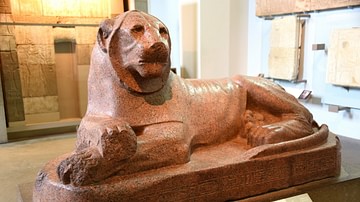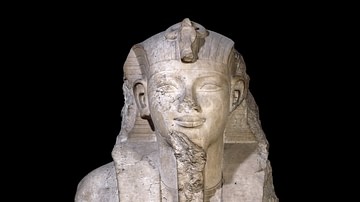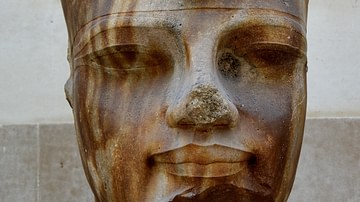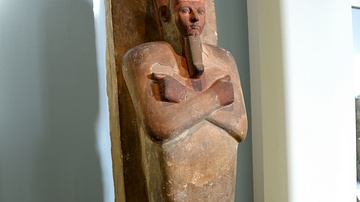Illustration
The enthroned pharaoh has idealized features and wears a striped head-cloth, false beard, and pleated kilt. A bull's tail, symbol of superhuman strength, hangs between the legs. Many Egyptian kings used the title of "bull" or "strong bull". Egyptian images serve to preserve the memory and spirit of those represented. Statues are not true portraits, but idealized, so inscriptions have to identify the owners. Amenhoptep's birth and throne names are written inside cartouches on the belt of the kilt and in his texts on the front and the back of the throne. Amenhotep's successor, Akhenaten, decreed that only the sun god Aten to be worshiped. Reference to other deities, especially Egypt's chief deity Amun, were everywhere destroyed, as in the inscription on this statue. Later Kings had these erasures restored. Even the name of Amenhotep, which means "Amun is satisfied", fell foul of Akhenaten's iconoclasm. 18th Dynasty, reign of Amenhotep III, circa 1390-1352 BCE. From the mortuary temple of Amenhotep III at Western Thebes, Egypt. (The British Museum, London).
About the Author
Cite This Work
APA Style
Amin, O. S. M. (2016, July 18). King Amenhotep III. World History Encyclopedia. Retrieved from https://www.worldhistory.org/image/5365/king-amenhotep-iii/
Chicago Style
Amin, Osama Shukir Muhammed. "King Amenhotep III." World History Encyclopedia. Last modified July 18, 2016. https://www.worldhistory.org/image/5365/king-amenhotep-iii/.
MLA Style
Amin, Osama Shukir Muhammed. "King Amenhotep III." World History Encyclopedia. World History Encyclopedia, 18 Jul 2016. Web. 15 Apr 2025.








